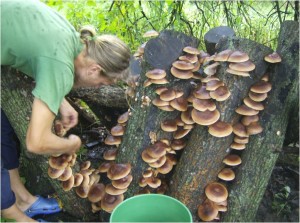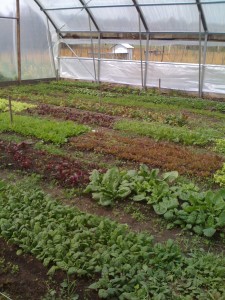Food Sources
Vegan or Vegetarian Diet?
Many people ask if you have to be vegan or vegetarian to live at DR. The answer is no. While many folks here eat a vegetarian or vegan diet for ecological, ethical or other reasons, we do not mandate any diet. We are open to having sustainable animal agriculture and have a few members who are raising their own chickens for both meat and egg production. For those interested in animal products we encourage getting them from local organic producers.
That said, a diet that is primarily vegan or vegetarian can significantly reduce one’s ecological impact compared to the mainstream American diet. Many people at DR who are omnivorous eat animal products only occasionally or in much lower quantities than the mainstream. Currently, most of the food you might find at our potlucks is vegetarian and/or vegan. Some of our food co-ops serve only vegetarian meals, and there is currently one vegan co-op as well.
Buying Food in Bulk
Currently, there is no one at DR pursuing large scale grain, pulse, or bean production so the majority of our staple foods come from an organic bulk distributor. Meeting our needs in this way allows us to buy food at lower prices, coordinate with neighbors for sharing orders, and reduce the overall amount of packaging waste that our food consumption produces. Some day, we could be producing more of our own food or meeting our needs through local organic farmers to reduce the necessity to transport food over long distances.
Organic Gardens
Our vision is to have gardens and orchards integrated in our village with small plots between homes and fruit trees throughout the village. There are already gardens of various sizes and configurations in and around the village. They produce many of the vegetables we consume, including those preserved for the winter. Some are moving towards growing produce on a larger scale with the use of hoop houses to provide fresh produce to other members for an extended growing season.
Wild Edibles
 We gather numerous wild edibles from our land, from blackberries to morels or lamb’s quarters. Another type of garden space being implemented at DR is the food forest. Food forests are gardens incorporating companion planting and a succession of layers of different types of plants including trees, shrubs, herbs, vines, and vegetables. They more closely resemble, and often include, the growing patterns and plant species of wild woodland habitats.
We gather numerous wild edibles from our land, from blackberries to morels or lamb’s quarters. Another type of garden space being implemented at DR is the food forest. Food forests are gardens incorporating companion planting and a succession of layers of different types of plants including trees, shrubs, herbs, vines, and vegetables. They more closely resemble, and often include, the growing patterns and plant species of wild woodland habitats.
Local Food Sources
Eating more locally is an important goal that our community strives toward. For the produce and food products that we don’t produce ourselves, we work to develop relationships with other communities, like Sandhill Farm and other local food producers, to provide healthy organic options. Local Harvest is a great resource for finding farmer’s markets and local farmers in your area.

